Driving through eastern Spain was a delight, but we stumbled upon an exceptionally rare surprise along the way. As I’ve mentioned in previous blogs, we’re all about road trips, especially when we get to venture down local roads and experience a place authentically—beyond the usual tourist spots.
Needless to say, we take a lot of detours. If we spot an interesting landscape or if TripAdvisor flags a place of interest, we’re the type to pull off at the next exit. All credit goes to Aji for encouraging me to embrace these off-the-beaten-path adventures. I can’t say enough about the amazing surprises we’ve uncovered over the years.
Even though I’m sometimes nervous about the unknown and unfamiliar, our experiences have built up a certain confidence. Living by the simple principle: all humans are good and mean no harm. This mindset has enriched our travels with incredible moments, connections, and places that we’d never have found if we’d just stuck to the highways. Keeping our fingers crossed.
Our road trip back to Barcelona from Granada was on October 12. As I mentioned in my previous road trip blog, the eastern region of Spain is peppered with fortresses; wherever you see a high point or mountain, someone has built a small fortress. These are remnants of the Moorish occupation when there was much unrest and conflict between the Moors and Christians. Most of them are in ruins and hardly look interesting. But coming from Chicago, you can imagine our curiosity to explore.
Somewhere close to Valencia, we saw a fortress or castle high up on a mountain. The place looked very much abandoned, but that piqued our curiosity, and we decided to take the exit and drive up to explore. We ended up in a small town called Montesa (a beautiful name, and yes, that was another reason to take the exit).
As we read in wiki later: Montesa, located in the province of Valencia, Spain, is a town rich in history and cultural significance and the landmark is the Castillo de Montesa, a castle that has been declared a historical-artistic monument. For centuries, it served as the headquarters of the Order of Montesa. Although an earthquake in 1748 caused significant damage, the castle’s remains still offer a glimpse into its storied past.

We drove in, and as we approached the center of the town, we saw some festivities taking place. We parked our car and decided to walk into the festival. Waiting for us was the most breathtaking parade—people adorned in war game costumes, loud music, face paint, and drums.
One street had participants wearing furs and holding large machetes and swords, while on the other side of the street were groups dressed as if they were from Arabian Nights, adorned with heavy face paint and accompanied by loud shouts and drums. It was some sort of war game. They were enacting a brutal battle right in front of us.

My imagination was running wild with Pirates of the Caribbean scenarios. I joked with Aji and told him to be ready to dance in his underwear or, better yet, be cooked in a cauldron.

Jokes aside and with curiosity high, we walked right in. I was in awe of the beauty of their costumes. The entire town was out, drinking, and there were rows upon rows of elegantly costumed parade participants. I tried talking to the locals to understand what was going on—and guess what? Not a single person knew a word of English. People were friendly, smiling, and sweet, which put me at ease. Finally, I found my guy, Leo (Handsome like a Mills and Boon hero- something is there in the Spanish air, they are a good looking lot ) in the crowd who knew some English. With his help and Google Translate, I finally understood what was happening.

It was the festival of Moros y Cristianos (Translates to Moors and Christians).Since then I learned that it is a local fare but different Spanish-speaking countries celebrate this festival.
About Moros y Cristianos

Valencia and the entire Iberian Peninsula were once occupied by Muslims (called Moors) from North Africa. They crossed the Strait of Gibraltar and ruled the peninsula from around the 8th century to the 15th century. In the 15th century, the Christian rulers, through multiple wars, recaptured the peninsula and converted the population to Christianity, thus ending Moorish rule.

Moros y Cristianos is a historic festival that reenacts these battles, conflicts, and the eventual coexistence between the Moors (Muslim rulers) and the Christians during the Reconquista period, when Christian forces reclaimed the Iberian Peninsula from Moorish control. The performances feature mock battles, with theatrical surrenders and negotiations to symbolize the complex history of conflict and cultural exchange.
Since this was a reenactment, there was one group dressed as Christians in furs and masks, and another group of Moors dressed as if they were from Arabian Nights. That explained everything. Our friend Leo kept repeating that this was a friendly affair contrary to the scariness of their get-up and that the festival celebrates the coexistence of the Moors and Christians in the region.
We took a lot of pictures with the costumed locals. I think, even though we couldn’t understand each other, the gesture of “Can I take a selfie with you?” is universally understood. The experience was magical, especially because it was unplanned and unexpected. We were offered beer, and locals suggested places to stay and eat but since we had miles ahead we bid our farewell to Leo and the beautiful community.
Amazing people, wonderful culture—I think I found my place there. If you are in the Valencia area of Spain in October, look up the festival and try to take part. It will be one of the best experiences of your life. It certainly was for us! Traveled the beaten path and you are likely to get a surprise (Disclaimer, if you get in trouble, I take no responsibility)
Remember—Montesa on Oct 2nd is great to add to your itinerary!